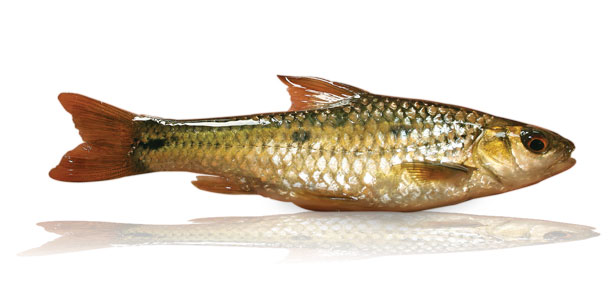
Barbus Trimaculatus (Threespot Barb, Threespot Ghielemientjie or “Ghielie”)
In the Artlure facet the Barbus Trimaculatis is commonly known as a “ghielie” and is regarded as a “bass delicacy”. Apart from the Southern Cape it occurs in almost all of the major bass venues in South Africa (see distribution map).
Even though the ghielie is common in South Africa’s bass waters, only the competitive Artlure facet targets them as a sport angling specie. Catches are made using a small plastic grub on number 24 to 32 hooks with a small split shot pinched on the line 10 to 20cm above the hook.
Description?
Live fish taken from clear water are silvery with an olive-brown to dark dorsal surface and three clearly visible, dark spots on the sides. These spots are usually about the size of the eye but in some specimens the anterior two may be in the form of an elongated dash. Because of the distinctive contrast these spots act as “trigger points” for a bass. Viewed from above the dorsal surface (its back) blends in with the bottom. They are very difficult to see if they are not moving and therefore blend in with the bottom of a dam or pond. When they interact with each other or feed on the bottom the silver flashes from their sides and belly as the scales reflect the light make them highly visible. They also tend to hang motionless in the water with sporadic, sudden dashes, and always swim together in shoals and continuously interact (play) with each other.
Ghielies have a slender profile but in certain dams can become quite plump. The silver scales on the sides reflect sunlight and cause bright flashes when feeding or interacting with each other. They have no harmful spikes, which makes it easy for a bass to swallow them, and in addition are oily fish with a high protein content.
Food Source
Ghielies are insectivores, namely their primary food source consists of water insects and plant material that contains caddis fly and mayfly larvae, dragonfly nymphs, adult water beetles and also certain plant seeds.
Size
In good conditions ghielies can reach a length of 15 cm (6 inches) in dams, such as the large specimens found in Hartbeespoort Dam over the last few years, but their normal length is around 10 cm (4 inches).
Distribution
Ghielies are hardy and commonly occur in a wide variety of habitats where vegetation is present. They breed in summer when shoals of mature adults move upstream after the first rains into the shallows to spawn when water levels start rising. Typical of a prey fish, they have a high level of fecundity with females producing as many as 8 000 eggs. During this period bass aggressively hunt them in the shallows. They are a schooling and migrating species (in dams they migrate vertically and horizontally depending on oxygen levels) that live and feed mostly on or near the bottom but also in mid water where structures such as trees occur. Ghielies can be located in depths ranging from the surface to 20 meters down, depending on the oxygen levels of the water they are in – ghielies require a lot of oxygen and the oxygen content of the water will determine how deep they go. Because they require a lot of oxygen they will be located near vegetation or in or near moving water such as in old river beds and wind blown shorelines. Because they are schooling fish ghielies can be located on the outside edges of vegetation where they feed on water insects and plant seeds. In a dam bear in mind that there is still an underwater current along the old river bed as water moves from the inlet to the dam wall. Ghielies will relate to rocky structures that are close to the drop-offs into these old river beds. Looking at their food source it is understandable why they are found on rocky bottoms, in trees and lay downs with algae and moss growth and on the edges of weed beds.
Research Findings
In laboratory research conducted in South Africa some amazing results regarding bass behaviour towards ghielies was observed.
It was noted that bass ate them even when they are appeared full and were rejecting other prey fish, and would even hurt themselves in their attempts to catch a ghielie. The bass would also ignore all other prey fish if there was only one ghielie among the fish that were being fed to them. It was also noticed how the bass would bump kurper species out of the way to chase the ghielie.
Ghielies are a true “bass delicacy” and have been used as extremely successful live bait for other predators such as Tigerfish.
How to imitate a Ghielie:
Sight fishing: Cast past the sighted bass with a weightless presentation; slowly move the bait to about 1.5m from the fish and give it two or three fast short jerks that activate the flash. As far as the bass is concerned the ghielie is in panic mode and a reaction strike is inevitable. But remember: if you can see a bass, it can see you, so a smaller bait with a slim profile works best.
On a hard rocky bottom: On a Texas rig hop the bait on the bottom using a short movement that imitates the flashing on the bottom. In fact, practice in shallow water where you can see the bait to get the flash right. This leads to aggressive strikes.
Grass and vegetation: On a weightless or Mojo rig fish the edges of vegetation such as grass, weeds or lily pads - cast into the vegetation and allow the bait to sink into it; then move it to the edge and let it “shoot” free as it comes through the vegetation into the open water. Also use the Texas rig simulating the flash on the bottom along the edges of the vegetation.
Submerged trees and lay downs: On a Mojo rig retrieve the bait through the branches and jump it forward as it releases from the branches to imitate a ghielie flashing as it moves through the cover. This method has fooled many a trophy bass that annihilated the bait shooting free of the branches. Bigger ghielies relate to this type of structure so use bigger baits to imitate them.
Drop-offs in old river beds: On a Mojo rig let the bait fall down the drop-off. In this situation a slimmer bait profile is more effective.
Conclusion
When fishing think about how the ghielie behaves and moves. When you fish in the right areas, using the right method and with the right action in the particular situation you can achieve amazing results.
Bear in mind that a juvenile bass is not very fussy, but if you want to consistently trigger a bite from a large, adult bass, do everything you can to put the odds in your favour - don't only match the hatch with the bait but fish it correctly.


 Visit us our
Visit us our